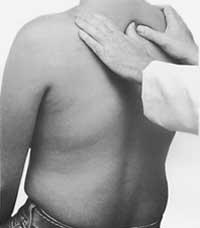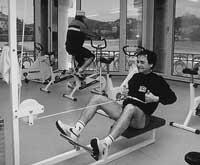Back pain
As mentioned in the introduction, there are many diseases that can lead to lumbalgia (more than 300 are counted as possible causes), but in most cases lumbalgia is due to degenerative diseases, congenital anomalies, rheumatism in soft parts and intervertebral disc problems.
Reasons: many and different

The onset of pain, its rhythm and the duration of the event provide us with reliable data to determine the causes that cause lumbalgia.
- Thus, mechanical lumbalgia, caused by muscular and tendon diseases or by osteoarthritis, is due to the movements of the spine and forced postures. It is the most visible type of lumbalgia and disappears or relieved with rest. The person gets up well from bed, without discomfort and throughout the day gets worse, doing more damage.
- On the other hand, inflammatory lumbalgia worsens with rest (the longer the time without activity, the more intense the pain) and, on the contrary, improves with movements. Typical symptoms are pain and stiffness when you get out of bed or sit or stand for a long time. Improvement of the patient as a result of work or activity carried out during the day.
- Infectious lumbalgia, for its part, is a continuous pain that is accentuated with any movement both in the morning and in the afternoon. At night the pain does not let the patient sleep.
Very different symptoms
When there is a disc herniation or the internal fibrous ring comes out due to disc deterioration, the pain will radiate to one of the lower extremities (in very few cases to both), almost always behind the leg and in some cases reaching the fingers. Pain does not always go away with rest and any movement that involves an increase in abdominal pressure, such as cough, will increase discomfort.
When there is stenosis or narrowing of the spinal cord canal, the symptomatology is usually something special: in addition to lumbalgia, when walking you feel pain and loss of strength in thighs and legs, cramps, tingling… are symptoms that improve when bending the spine.
These patients often have pain when walking upright and are often forced to stop. When they go on a bicycle they have no symptoms, since in that position the column is bent. Mechanical lumbalgia, caused by muscle contraction or by alterations in tendons or ligaments, usually disappears in fifteen days. If they last more than six weeks, we must begin to think that the patient has another disease, usually some pathology of the intervertebral disc.
Varied treatment
We have seen that the causes of low back pain are many and different. Therefore, the proper clinical history and direct physical examination of the patient are fundamental for the correct diagnosis.
Once the diagnosis is made we will begin with the treatment. Often the disease that produces lumbalgia, such as osteoarthritis, spondylosis or hyperostoria, has no curative treatment, since they are chronic or degenerative processes. In these cases treatment will be directed to relieve pain, maintain mobility and reduce inflammation.

Since always doctors have recommended rest to treat low back pain and it is possible that in some cases, at least at first, it is recommended. However, in recent years it has been observed that maintaining a certain activity palia symptoms and facilitates recovery.
Avoid high weights and maintain forced postures for long periods of time. Avoid prolonged travel and sudden movements. Moving, walking, doing everyday activities (as far as possible) are the measures that can be positive in the healing process of low back pain. However, in special cases (disc herniation or infections for example) rest will be mandatory and necessary.
The daily development of a special spine exercise program is the most effective way to achieve recovery, maintain mobility and flexibility and prevent relapses. They are very suitable in cases of chronic low back pain and can be performed at home. The local heat (heating a dry cloth or an electric blanket) also has very good results, especially to release muscle contractures.
The treatments of chiropractors and masseurs are currently very discussed. In a recent study conducted in the US a comparison was made between the treatment of general physicians, traumatologists and chiropractors, without differences in the evolution of the patients with respect to the results.
Prevention, if possible
- It is convenient to keep it active and perform exercises that facilitate lumbar flexibility and muscle strength.
- Avoid sudden, sharp and violent movements, especially when you are not working long and the body has not heated properly.
- Properly handle weights: hold the load well by keeping it close to the body and lift it with the strength of the thighs instead of supporting the spine, keeping the feet well supported.
- Avoid combined movements that simultaneously demand bending and rotation of the column. Make the movement gradually, without force blows.
- Start to prevent from small (column deviations, foot alterations, dysmetries, etc. ). ). Teach children appropriate postures so that tensions do not occur in muscle groups, so that development is done in a balanced way and to maintain flexibility.
- The best prevention against mechanical pain is its good shape (although these lumbalgias are benign).





